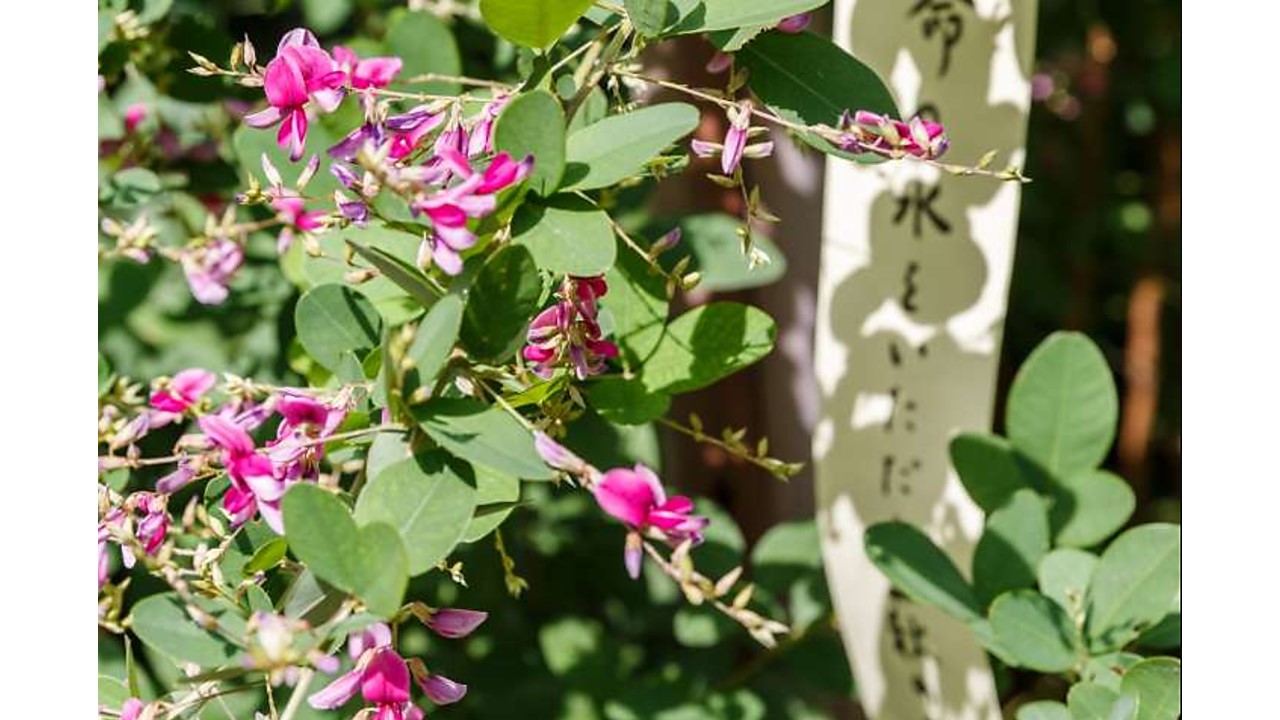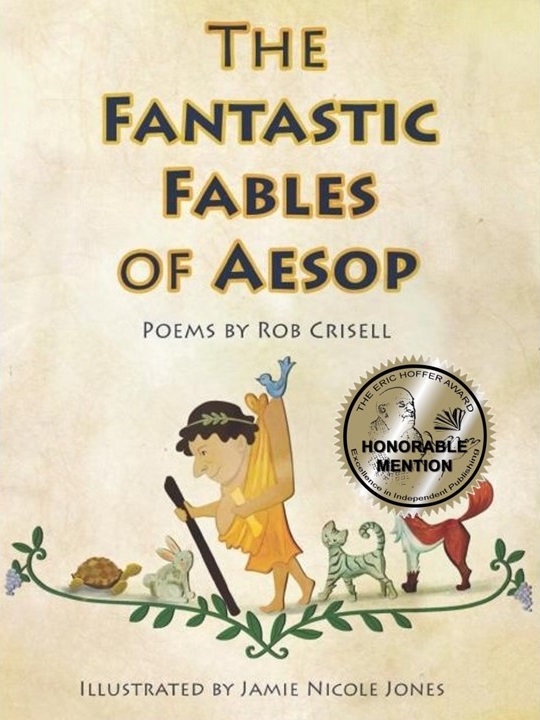.
Hagi at My Study Window
hagi or bush clover, a symbol of poetry, blooms as summer turns to autumn.
Paper shapes the future’s surface,
Paperweights the present state.
Inkstones hold a scholar’s treasure:
Ink, the past in pine-soot sticks.
Water droppers moisten motion
Brushes pensively perform,
Taken from a jade container,
Set to dry on ironwork rests.
Wit, diversion, labor, pleasure,
Sealed with cinnabar clay paste
By the writer’s cherished signet
Carved in wood or costly stone,
Haiku hang from hagi branches;
See the scene of leaves breeze-blown.
.
.
The Literary Month
seventh lunar month (early August through early September)
Through thinnest clothes, fatigue evaporates,
To be replaced by verbal stimulants.
Old books are aired, and mildew dissipates
With sentimentalism’s ignorance.
The sight of summer grasses germinates
Fresh verses flowing faster, filling sheets
To energize whatever militates
Against despair at liberty’s defeats.
.
.
Summer Grasses
This is one of Basho’s most celebrated haiku, composed in tears while visiting the site where Minamoto Yoshitsune (1159–1189) had lived, but where no building remained.
by Matsuo Basho (1644-1694), translated by Margaret Coats
Summer grasses grow
Where noblest ancient warriors
Laid their heads to dream.
.
Japanese original
Natsukusa ya
tsuwamono-domo ga
yume no ato.
.
.
The Mighty Eel
A windbell chimes faint welcome as the air
Stirs slightly. In the shop, we take our seats
For one of summer’s most prodigious treats:
Freshwater eel, sweet, rich grilled meat that beats
Down sluggishness—real strength-inducing fare!
Here’s roasted barley tea, well chilled,
Small glasses colored and engraved;
Cut crystal leaves us drinkers filled
With cool serenity we craved
As incense vile mosquitoes stilled.
The lacquer boxes come; we lift each lid,
Warm and slick and shiny, to behold
Unagi in its sauce of savor bold.
The food is fat with stamina untold;
Its flexile power edible, yet hid.
Brown rice beneath it meets a need
For commonplace accompaniments
While crunchy pickled carrots feed
Weak thews’ and sinews’ competence,
Restoring vigor atrophied.
Then watermelon sweet,
Like eel itself, supplies
A seasonal oasis
To ably exorcise
Lethargic hungry heat.
.
thews and sinews: manners and muscles
.
.
Margaret Coats lives in California. She holds a Ph.D. in English and American Literature and Language from Harvard University. She has retired from a career of teaching literature, languages, and writing that included considerable work in homeschooling for her own family and others.















These are four exquisite late summer gems — hugely evocative of the best of Japanese culture. Of the four, my favorite is “Hagi at my Study Window” which evokes the poet’s art with such gorgeous imagery.
As you probably know, the images are desk items essential for doing brushwork calligraphy. This time of year, there are usually poets’ gatherings at places where they can post their work on hagi bushes. I hope some of that is going on despite health constraints. Amazing displays!
These are all lovely, Margaret, and my goodness, how many languages do you know?
To me the brightest, or rather the most hopeful lines are “Old books are aired, and mildew dissipates / With sentimentalism’s ignorance.”
Yes, Julian, let’s air some old books! Reading more of them would certainly dispel ignorance, and might even dry out some soggy sentimentality. Best wishes in your library!
I can read poetry in nine languages, but the key to that is studying just one (other than your native language) as thoroughly as possible, and reading extensively in it. Then you know something of language itself. Anyway, that is my advice to anyone who still has time and opportunity for language learning.
Margaret, these poems are so expressive of the climate. Time seems irrelevant — centuries roll by and yet the scents and tastes remain strong and vigorous.
I love the idea of creating an atmosphere of particulars out of a list of foods consumed centuries ago.
In the Eel poem I notice that you do something I often attempt in a painted still life — that is, I place a taste of this, a strong aroma on a saucer, in a tureen or just one bowl. I have, over the years, painted a series of “food” still lives which I offer in all their culinary glory, but carefully remove all utensils and dinner plates, so no one can actually receive the nurishment, but may only enjoy the food in an artistic or poetic way. In a sense you have done some of this here, but your approach is different, and certainly more hopeful. You hold out an enticement of riches and we are given a choice as to what we will do about it.
That is my take on what you have done; particularly in the Eel poem; and have done brilliantly.
Sally, I very much enjoy hearing of your still life series about foods. I do recommend actually enjoying unagi at a Kyoto specialty restaurant, for anyone who is there and can afford it. But do it as a treat you’ll remember for a lifetime! The eels are now endangered and the meal has become much more expensive, due to neglect of the local and seasonal nature of the experience. Asian supermarkets worldwide will sell you grilled eel in shrink-wrapped plastic, at almost any time of year. Not the same. Please enjoy instead the poem in the approximate shape of unagi pieces served in red-and-black lacquer boxes (do a computer search for Images of “unagi,” and favor those with the thickest, reddest sauce). Then look around you for fine seasonal products available from your own local producers.
Or get out your best glassware. Glass looks like ice, and should put you in a cool mood. That’s what the Japanese thought when glass was first imported in the late 19th century. They learned to make it, and created cut colored crystal especially for summer drinks, as I’ve described in the poem for old-fashioned barley tea, elevated to iced summer nectar by its mode of service. Poetry of the table!
Thanks, Sally, for suggesting these explanations.
Well composed and interesting glimpses into a different culture. It’s good to be reminded of the rich variety which exists in this world. I particularly enjoy The Literary Month. Even though it contains enough action verbs, in my mind it paints a still-life picture in which I can also picture myself, probably because the subject matter is so relatable.
Yael, I’m so glad you could find yourself in The Literary Month. There is a lot of activity there, with airing out old books and other things in a house, as well as writing new poetry because the time is right, but all around us is a summer still life composed by the world of nature. Thanks for your reading and comment!
There is always something new to be learnt from your poetry Margaret.
My favorite is the “The Mighty Eel” due to its richly detailed description of a complete cultural experience, rather than simply a meal.
“Hagi at My Study Window” provides a poetic window to what is assuredly a relaxing view.
David, you can imagine that when I heard about eating rich, fatty eels as an energizer at the hottest time of the year, I was doubtful. You are right that much more goes into the experience. And maybe when we get to Australian summer months, you will have a poem that can give us full details about an authentic Australian barbecue!
Margaret, that first poem is both masterful and beautiful. Thank you for sharing it with us.
Of this group, “Hagi” seems to me the one that challenges the reader most. I’m glad you found it enjoyable, Talbot. Thanks for your attention!
Margaret, these poems are a beam of sunshine in an increasingly stormy world. My favorite line is; “See the scene of leaves breeze-blown.” I love the wide stretch of the mouth when reading this aloud. One cannot help but smile!
My favorite poem is ‘The Mighty Eel’. It engages all the senses and elevates the ‘watermelon sweet’ eel to ambrosial heights, and that is no mean feat. I loathe eels. I’ve grown up witnessing people wolf down jellied eels – a favorite dish of the cockneys on the streets of London. My dad loved them, and always tried to sell them to me as the cleanest, sweetest fish. All I saw was a grey snake in snot-like jelly. I used to see eels in wooden tubs outside fishmongers. My friend’s mum bought and prepared an eel in front of me once. She chopped its head off and it continued to bite and gasp as its body still wriggled. Margaret, your poem has made me want to try a bite of eel for the very first time in my life… I declare ‘The Mighty Eel’ a poetic triumph! Whoever said poetry isn’t therapy may be misguided. 😉
Susan, you had much more eel experience than I did! I had seen only pictures in books, and I was pleasantly surprised to find that grilled unagi bore no resemblance to my imaginary concept of a live eel. I’m sure the taste and texture were much enhanced because preparation had been done out of my sight, by specialist restaurateurs. Therefore, before taking a bite, look at what I said to Sally Cook above. There must be some great coastal Texas summer delicacies that are better worth your attention at present, but I very much appreciate your declaring “The Mighty Eel” a poetic triumph. It’s always great to be able to convey a cherished pleasurable memory to someone else, and you’re right that we need more of that.
I much enjoyed all these poems, and the poem on hagi brought back some memories of Japan, just at the moment when the sweltering heat of late summer begins to dissipate.
The haiku of Basho is one of his most profound, and I thought perhaps your readers would enjoy reading some other renderings in English that have been published in various anthologies. 17 syllables can be rendered in so many ways! Spacing is another tool of the translator.
summer grass:
all that remains
of warriors’ dreams
[David Landis Barnhill]
Summer grass: where the warriors used to dream
[Hiroaki Sato]
Summer grasses:
the afterward of strong men’s dreams.
[Harold Henderson]
Margaret’s version is up there with the best!
Thank you, Tom! More translations online, for anyone who does a search for “Basho Summer Grass.” I am working with Toshiharu Oseko’s 1990 book, “Basho’s Haiku,” invaluable for thoroughly explaining background, vocabulary, and grammar of about 200 poems. His literal translation is:
Only summer grass grows
Where ancient warriors
Used to dream!
I accepted his “ancient” as suitable for the archaic plural suffix to “warrior,” which also has to do with rank, though it could mean “humble” rather than “noble.” I went for “noblest” because of the well-known circumstances of composition–and the fact that Yoshitsune’s high status as a cultural icon seems to remain unfaded.
You are so right about the sweltering final days of summer in Japan! My children would not go out without a “sweat cloth” (more like a sturdy wash cloth than a handkerchief), in addition to a cap or parasol.
Margaret, I don’t know the Oseko book, but I look forward to seeing a copy.
“Ancient” is surely the best choice.
By the way, I also found the translation by Donald Keene, my revered professor at Columbia, who renders the poem this way:
The summer grasses —
Of brave soldiers’ dreams
The aftermath
How remarkable it is that 17 syllables can be rendered in so many ways.
A tribute to the poet, I think, who can suggest so much in a small verbal space.
Tom, I will have to show you the book whenever we can next meet. The author himself is listed as publisher, although it was produced in cooperation with Maruzen. Too bad it is no longer available, as it enables English speakers to really feel the poems in depth. You are right about what a tribute it is to Basho to suggest so much with so little in the way of words. It opens up another level of meaning to realize (as Oseko points out) that the poem alludes to one by the Chinese poet Du Fu.
A SPRING VIEW by Du Fu
Although a country has been defeated,
Its mountains and rivers still remain.
Time is spring, the grass is green
All over in the ruined city.
Basho moves the thought from spring into summer, and the grass is no longer green. The situation has matured. With this as background known only to the literati, the famed haiku is doubly profound.
I totally loved the first poem — this line, “Haiku hang from hagi branches;” is super. Just exquisite. I don’t think I force too much in there to see the layers. First, literal beautiful, the crafted paper, ink, verse; the cultivated flower. Second, the line doing what it says, haiku are to convey through sense imagery alone; also done. In fact, I regard the line as an embedded haiku. Awesome. Third, Hagi/Haggai, (perhaps associated for all kinds of errors on my part), he who prophesied the rebuilding of the temple/carried the command to do so. This poem subtly inspires and commands us toward a similar rebuilding of beauty in our time.
Thank you so much for this comment, Daniel. I too see multiple layers to the poem and to hagi itself, which has long been an important symbol for me personally. I would not, however, have thought of bringing in the prophet Haggai. But now that you mention him, I will take the thought of him as a call to restore beauty in general, but in particular, beauty in what is sacred. There is a book on contemporary church architecture with the title “Ugly as Sin.” And no wonder that expression is proverbial for the ugliest things imaginable.
Because the plant hagi symbolizes poetry, I have developed a fondness for how it is represented in Japanese lacquerware and painting. The other important manifestation of hagi in Japanese culture is as a kind of pottery. Again, something handmade that should represent artistic skill in every piece. I can see that I have more hagi poems to come, providing God gives me time to return to this season in the future.
I love this Hagi at My Study Window poem and have copied it down. It presents one manifestation of the beautiful desk ideal in such a way that it becomes a type. It has the quality of a well-ordered catalogue, a litany. With all those beautiful things in it, it still seems to have plenty of space: space around each thing so that it’s fully and finely appreciated before the next is introduced. It could be a tea ceremony of the study!
A spirit of hospitality characterizes so much of your poetry: hospitality and education and the intersection of the two. They intersect here with particular clarity and loveliness.
I’ve been reading a smattering, here and there, on the internet, of haiku, with little dips into haiku theory. Some “schools” have so many rules that writing a haiku seems to become as precise and arcane as making a kosher mezuzah scroll. And something in me likes that.
Also what a beautiful mezzo-season, cleave of the year, these poems report on!
Monika, here in late winter, I’ve finally noticed your bracing comments on the mezzo-season of late summer, and my poems for it. It’s encouraging to hear that much of my poetry shows a spirit of hospitality. That says it serves one purpose or “end” of a poem in appealing to the conscientious reader. Thank you so very much for being an excellent guest.